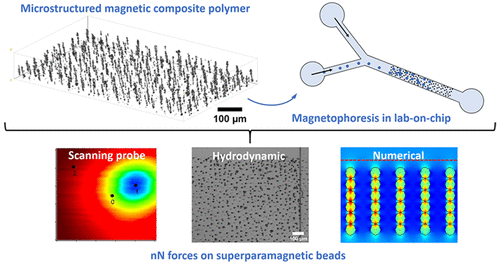Our official English website, www.x-mol.net, welcomes your
feedback! (Note: you will need to create a separate account there.)
Nanonewton Magnetophoretic Microtrap Array for Microsystems
Langmuir ( IF 3.7 ) Pub Date : 2020-11-25 , DOI: 10.1021/acs.langmuir.0c02254 Samir Mekkaoui 1 , Lucie Descamps 1 , Marie-Charlotte Audry 1 , Anne-Laure Deman 1 , Damien Le Roy 2
Langmuir ( IF 3.7 ) Pub Date : 2020-11-25 , DOI: 10.1021/acs.langmuir.0c02254 Samir Mekkaoui 1 , Lucie Descamps 1 , Marie-Charlotte Audry 1 , Anne-Laure Deman 1 , Damien Le Roy 2
Affiliation

|
Here we report on the development of a lab-on-chip that integrates a dense array of micrometer-sized magnetic traps, with each individual trap generating a magnetic force as high as a few nN on standard superparamagnetic beads. The composite materials embedding traps are prepared from the microstructural engineering of a mixture between iron microparticles and polydimethylsiloxane. This approach breaks with standard microfabrication technologies: it is inexpensive, relatively easy to implement, and offers the ability to modulate the magnetic properties of the composites on a customized basis. The magnetic forces acting on the superparamagnetic beads have been measured following two approaches: first, on-chip through the hydrodynamic determination of the holding magnetic force, simultaneously on a large population of traps; and second, ex situ, by atomic force microscopy equipped with a colloidal probe, on individual traps. The experimental results have been compared with calculations from finite element modeling. Despite the geometrical simplification of the modeled system, both experiments and calculations give consistent values of force, ranging from 0.5 to 5 nN. These findings show that in operando determination of forces is a robust method that gives a high throughput overview of the forces acting in the device. It further demonstrates that the use of such functional composite materials can be a relevant alternative to standard microfabrication technologies, as it leads to competitive magnetophoretic performances.
中文翻译:

用于微系统的纳米牛顿磁致微陷阱阵列
在这里,我们报告了一个芯片实验室的发展情况,该芯片集成了微米级磁陷阱的密集阵列,每个陷阱在标准超顺磁珠上产生的磁力高达nn。复合材料包埋阱是由铁微粒和聚二甲基硅氧烷之间的混合物的微结构工程制得的。这种方法与标准的微细加工技术相违背:它价格便宜,相对易于实施,并且能够在定制的基础上调节复合材料的磁性能。已经通过以下两种方法测量了作用在超顺磁珠上的磁力:第一,通过流体动力学确定保持磁力的芯片,同时在大量陷阱上进行;第二,非原生境,通过原子力显微镜在单个阱上配备了胶体探针。实验结果已经与有限元建模的计算结果进行了比较。尽管对建模系统进行了几何简化,但实验和计算均给出了一致的力值,范围从0.5到5 nN。这些发现表明,在操作中确定力是一种鲁棒的方法,可提供对设备中作用力的高吞吐量概览。它进一步证明,使用这种功能性复合材料可以替代标准的微细加工技术,因为它可以带来具有竞争力的磁泳性能。尽管对建模系统进行了几何简化,但实验和计算均给出了一致的力值,范围从0.5到5 nN。这些发现表明,在操作中确定力是一种鲁棒的方法,可提供对设备中作用力的高吞吐量概览。它进一步证明,这种功能性复合材料的使用可以替代标准的微细加工技术,因为它可以带来具有竞争力的磁泳性能。尽管对建模系统进行了几何简化,但实验和计算均给出了一致的力值,范围从0.5到5 nN。这些发现表明,在操作中确定力是一种鲁棒的方法,可提供对设备中作用力的高吞吐量概览。它进一步证明,使用这种功能性复合材料可以替代标准的微细加工技术,因为它可以带来具有竞争力的磁泳性能。
更新日期:2020-12-08
中文翻译:

用于微系统的纳米牛顿磁致微陷阱阵列
在这里,我们报告了一个芯片实验室的发展情况,该芯片集成了微米级磁陷阱的密集阵列,每个陷阱在标准超顺磁珠上产生的磁力高达nn。复合材料包埋阱是由铁微粒和聚二甲基硅氧烷之间的混合物的微结构工程制得的。这种方法与标准的微细加工技术相违背:它价格便宜,相对易于实施,并且能够在定制的基础上调节复合材料的磁性能。已经通过以下两种方法测量了作用在超顺磁珠上的磁力:第一,通过流体动力学确定保持磁力的芯片,同时在大量陷阱上进行;第二,非原生境,通过原子力显微镜在单个阱上配备了胶体探针。实验结果已经与有限元建模的计算结果进行了比较。尽管对建模系统进行了几何简化,但实验和计算均给出了一致的力值,范围从0.5到5 nN。这些发现表明,在操作中确定力是一种鲁棒的方法,可提供对设备中作用力的高吞吐量概览。它进一步证明,使用这种功能性复合材料可以替代标准的微细加工技术,因为它可以带来具有竞争力的磁泳性能。尽管对建模系统进行了几何简化,但实验和计算均给出了一致的力值,范围从0.5到5 nN。这些发现表明,在操作中确定力是一种鲁棒的方法,可提供对设备中作用力的高吞吐量概览。它进一步证明,这种功能性复合材料的使用可以替代标准的微细加工技术,因为它可以带来具有竞争力的磁泳性能。尽管对建模系统进行了几何简化,但实验和计算均给出了一致的力值,范围从0.5到5 nN。这些发现表明,在操作中确定力是一种鲁棒的方法,可提供对设备中作用力的高吞吐量概览。它进一步证明,使用这种功能性复合材料可以替代标准的微细加工技术,因为它可以带来具有竞争力的磁泳性能。











































 京公网安备 11010802027423号
京公网安备 11010802027423号